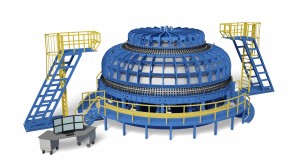 A wrench and hammer might be good for some building projects, but the nuts and bolts found in a standard garage toolbox definitely wouldnt hit the nail on the head when it comes to constructing a 321-foot, 5.5 million-pound rocket.
A wrench and hammer might be good for some building projects, but the nuts and bolts found in a standard garage toolbox definitely wouldnt hit the nail on the head when it comes to constructing a 321-foot, 5.5 million-pound rocket.
Engineers at NASA’s Michoud Assembly Facility in New Orleans are installing massive tools one more than 170 feet tall specifically designed and built to weld together pieces of the core stage of the Space Launch System (SLS) NASAs new heavy-lift rocket that will send humans to deep space destinations, including an asteroid and Mars.
One of the challenges that we face in building this large core stage is to develop world-class tooling using modern manufacturing methods in an affordable way, while maintaining the scheduled first launch in 2017, said Tony Lavoie, manager of the Stages Office at NASAs Marshall Space Flight Center in Huntsville, Ala.
This tool set that weve developed for Michoud to build the core stage is a perfect blend of those requirements and constraints.
Six substantial welding tools will be used to handle assembly of the new cryogenic core stage on SLS. Suppliers worked with NASA and The Boeing Company of Huntsville over the course of a year to design and build the tools. Boeing is the prime contractor for the SLS Core Stage, including avionics.
The tools include:
The Circumferential Dome Weld Tool will be used to perform circumferential friction stir welds in the production of dome assemblies for the SLS core stage cryogenic tanks.The Gore Weld Tool will perform vertical conventional friction stir welds in the production of gore assemblies for the SLS core stage tanks. Gores are preformed aluminum alloy dome segments that are welded together to make the dome.The Circumferential Dome Weld and Gore Weld tools are special tooling for the Enhanced Robotic Weld Tool used to make dome components for SLS.The Vertical Weld Centre is a friction-stir-weld tool for wet and dry structures on the SLS core stage. It will weld barrel panels together to produce whole barrels for the two pressurized tanks, the Intertank, the Forward Skirt and the Aft Engine Section. It stands about three stories tall and weighs 150 tonnes.The Segmented Ring Tool will use a friction-stir-weld process to produce segmented support rings for the SLS core stage. The rings connect and provide stiffness between domes and barrels.The Vertical Assembly Centre (VAC), wher domes, rings and barrels will be joined together to complete the tanks or dry structure assemblies. The tool also will perform nondestructive evaluation on the completed welds. The VAC, measuring 170 feet tall and 78 feet wide, is one of the world’s largest welding tools. It is anticipated to be completed in 2014.It’s an exciting time to be a part of NASA’s team, said Rick Navarro, Boeing operations manager at Michoud.
We’re already welding on the new tooling and are gathering information we’ll need to start production welding. That old saying, measure twice, cut once, applies in spades when you’re building a 5.5 million-pound rocket. We do a lot of testing, validating and what we call ‘qualifying’ welds that ensure we have all the information we need to build with 100 per cent quality assurance.
NASA and Boeing are designing, developing, building and testing the core stage and avionics. The rocket also will use proven hardware from other programs like the space shuttle a significant affordability benefit.
We are one step closer to building the first core stage in what will hopefully be a long line of rockets to support future NASA missions, said Lavoie.
For more information, view a PDF on the project here.




